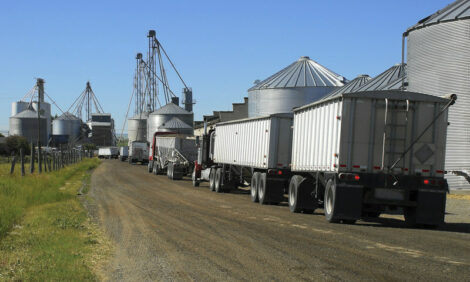



CME: Highlights of Latest Pig Crop Report
US - USDA released on Monday (27 December) the results of its quarterly survey of hog and pig operations, providing a benchmark estimate for total inventories as of 1 December 2010, write Steve Meyer and Len Steiner.On
page 2 (see link below) we have included a summary table with the latest results from
this report, below are some of the highlights and our first take:
We view the results of this survey as moderately bullish
for hog futures when they open on Tuesday, especially for
deferred contracts. The total hogs and pigs inventory was pegged at
64.325 million head, 0.9 per cent lower than a year ago. Pre-report estimates
were on average looking for a 0.5 per cent decline in the total inventory number.
The inventory of breeding animals as of 1 December was reported
to be 5.778 million head, 1.2 per cent lower than a year ago and just 8,000
larger than the 1 September count. Combing into this report, pre-report
estimates were looking on average for a 45,000 head gain over
the 1 September count although we had our doubts on that estimate
(see DLR 12/23). Sow slaughter picked up in October and November as grain prices began to ratchet up , erasing much of the gains
made by some producers. The inventory of market hogs was reported at 58.547 million head, 0.8 per cent lower than a year ago. Prereport
estimates were looking for the inventory of market hogs to be down 0.5 per cent. We were a bit puzzled that USDA estimated
the inventory of +180 lb. hogs at about the same level as a year ago even though daily and weekly slaughter numbers have been
tracking about 4 per cent ahead of last year for December. The inventory of light hogs (50 pounds or less) was estimated at 18.564 million
head, 2.7 per cent lower than a year ago and very much apart from pre-report estimates, which were looking for a feeder pig inventory
similar to year ago levels. The inventory of hogs in the 50—119 pound range was 16.519, 3.2 per cent lower than a year ago and
quite a bit different from the 0.5 per cent decline indicated by analysts in their pre-report estimates. The decline in these two categories
is clearly bullish for pork prices in the first few months of 2011. Even with the strong gains in hog carcass weights, overall pork
production will remain in check in the foreseeable future.
While the total inventory numbers were still relatively close to pre-report estimates, the USDA numbers indicated that
producers remain quite worried about the future. High feed costs are a particular concern for many producers, and this is
reflected in farrowing intentions, which were sharply lower than analyst forecasts. The range of analysts’ estimates for the Mar
- May period was looking for a 0.5 per cent to 2 per cent increase over year ago levels. The USDA report, however, showed that producers actually
plan to cut farrowings by a whopping 2.3 per cent compared to the already low levels of 2010. This implies a likely contraction in
US hog slaughter in the second half of 2011, which runs counter most estimates we have seen for US hog production next year.
The latest WASDE report indicated a 1.2 per cent increase in US pork production for H2 of 2011. Keep in mind, however, that the overall
decline in slaughter will be smaller than the farrowings numbers indicate as producers continue to improve productivity, with
the number of pigs saved per litter growing at about 2 per cent, offsetting a good portion of the farrowing declines. The chart below
shows that while farrowings have declined sharply in the last two years, the pig crop has declined by a much smaller amount.

Further Reading
| - | You can view the full report by clicking here. |








